Education > QUESTIONS & ANSWERS > SEJPME 1 Module 5 Test (All)
SEJPME 1 Module 5 Test
Document Content and Description Below
SEJPME 1 Module 5 Test 1) Which of the following are true when forming priority intelligence requirements? (Select all that apply The JFC's PIRs should prioritize the most urgent inte... lligence requirements. PIRs are any subject for which there is a need to collect information or produce intelligence. Staff must be aware of intelligence requirements of higher, adjacent, subordinate and supporting elements. 2) Automation technology can be used to reduce the burden of sorting through large amounts of _____ to enable an analyst to correlate various sets of _____ to make an assessment. data, information intelligence, data data, intelligence information, intelligence 3) Collection activities acquire and extract data from the operational environment such that Processing and Exploitation can convert that data into information to be used during Analysis and Production to refine into _____ to satisfy Requests for Information (RFI) or the commander's Priority Intelligence Requirements (PIR). information intelligence data fee translation 4) To be successful, a joint force commander must be able to influence and coordinate a diverse coalition of joint and multinational forces as well as civilian agencies and groups. What are some of the civilian groups the JFC must consider? (Select all that apply.) Host nation agencies Multinational forces State and local militias Nongovernmental organizations 5) This intelligence product category forecasts current or potential situations with implications for planning and executing military operations. Current Intelligence Estimative Intelligence Warning Intelligence Target Intelligence 6) Analysis is a synthesis of quantitative analysis and qualitative judgment and therefore rarely subject to competing interpretations. True False 7) Which two of the following statements highlight the critical features of intelligence? Allows anticipation or prediction of future situations and circumstances Informs decisions by illuminating the differences in available courses of action Contributes to or shapes the commander's decision making process Provides raw, factual information on a wide variety of subjects 8) What are the J2's responsibilities toward multinational intelligence support? (Select all that apply.) Having personnel knowledgeable of the foreign disclosure policy and procedures Integrating multinational intelligence personnel Providing a releasable collection management plan Assuring unity of effort against a common threat 9) Intelligence should increase the commander's understanding of the threat and adversary's probable intentions, end states, objectives, most likely and most dangerous COAs, strengths, and critical capabilities. This allows the J2 to _____. approve the command Joint Manning Document define Commander's Critical Information Requirements (CCIR) identify, define, and nominate objectives which are consistent with the threat and are relevant to the JFC's mission and intent direct Joint Reception, Staging, Onward movement and Integration (RSO&I) 10) Who is/are responsible for providing maps, charts, digitized products, and precise geodetic coordinates? Intelligence Analysts Geospatial Information and Services Officer Targeteers Collection Managers 11) Why does collection planning require the ability to call on a variety of collection sources? To provide spare assets on call in event of cancellations To allow flexible tasking of assets To ensure subordinate units maintain situational awareness of PIRs To minimize the effects of enemy deception 12) What category of intelligence is produced for the President, Congress, Secretary of Defense, senior military leaders and Combatant Commanders? Doctrinal National security Theater strategic National strategic 13) Match each intelligence product category to its brief description. a) Involves the integration of time-sensitive, all-source intelligence and information into concise, objective reporting on the current situation in a particular area. b) Examines foreign developments in basic and applied sciences and technologies with warfare potential, particularly enhancements to weapon systems; addresses overall weapon systems, tactics analysis, and equipment effectiveness. c) Results from the fusion of identity attributes (biologic, biographic, behavioral, and reputational information related to individuals) and other information and intelligence associated with those attributes collected across all intelligence disciplines. d) Information gathered and activities conducted to identify, deceive, exploit, disrupt, or protect against espionage, other intelligence activities, sabotage, or assassinations conducted for or on behalf of foreign powers, organizations, or persons, or their agents, or international terrorist organizations or activities. e) Forecasts of current or potential situations with implications for planning and executing military operations; includes a description of relevant actors' capabilities, and reporting of their activities, and it analyzes known factors using techniques such as pattern analysis, inference, and statistical probability to address unresolved variables. f) Portrays and locates the components of a target or target complex, networks, and support infrastructure, and indicates its vulnerability and relationship to the enemy Centers of Gravity (COG); consists of analysis of physical and virtual attributes and signatures as well as Battle Damage Assessment (BDA) resulting from the application of lethal or non-lethal military force. g) Provides a distinct communication to a decision maker about threats against U.S. security, interests, or citizens; carries a sense of urgency, implying the decision maker should take action to deter or mitigate the threat's impact. h) Focuses on the military capabilities of foreign countries and organizations to include non-state actors, and other topics that could affect potential US or multinational military operations. Counterintelligence a b c d e f g h Scientific and Technology Intelligence a b c d e f g h Identity Intelligence a bc d e f g h Current Intelligence a b c d e f g h Warning Intelligence a b c d e f g h Estimative Intelligence a b c d e f g h Target Intelligence a b c d e f g h General Military Intelligence a b c d e f g h 14) Which of the following non-DoD intelligence communities supports HUMINT collection, all source analysis, and political, economic, and biographic intelligence? Central Intelligence Agency (CIA) Department of Energy (DOE) Federal Bureau of Investigation (FBI) Department of State (DOS) Bureau of Intelligence and Research 15) Joint intelligence planning supports joint operation planning and may result in the production of what three products? Dynamic Threat Assessment Annex B: Intelligence National Intelligence Support Plan Contingency Plan 16) The _____ is the primary intelligence organization that provides support to the combatant commands. National Joint Operations and Intelligence Center (NJOIC) Joint Intelligence Operations Center (JIOC) Defense Intelligence Agency (DIA) Joint Intelligence Support Element (JISE) 17) Assuming the truism that intelligence is imperfect, what is the best way to minimize the obstacles to achieving a high degree of fidelity in the products of intelligence? Staffing efforts to achieve a mix of skills and characteristics that enable them to remain responsive a changing environment Anticipating the changing operational environment and focusing collection efforts to support ongoing operations Collaborating with allies and coalition partners who possess niche expertise and alternative perspectives that complement joint force intelligence efforts Constantly strive to maintain the highest possible standards of excellence 18) Commanders use intelligence to _____. (Select all that apply.) support a predictive estimation of the situation understand adversary capabilities and intentions visualize and understand all dimensions of the OE 19) Which of the following types of intelligence focuses on adversary military capabilities and intentions and helps the JFCs and component commanders keep abreast of events within their area of interest? Theater strategic Tactical Operational Target [Show More]
Last updated: 1 year ago
Preview 1 out of 3 pages
Instant download

Buy this document to get the full access instantly
Instant Download Access after purchase
Add to cartInstant download
Reviews( 0 )
Document information
Connected school, study & course
About the document
Uploaded On
Feb 14, 2021
Number of pages
3
Written in
Additional information
This document has been written for:
Uploaded
Feb 14, 2021
Downloads
0
Views
103

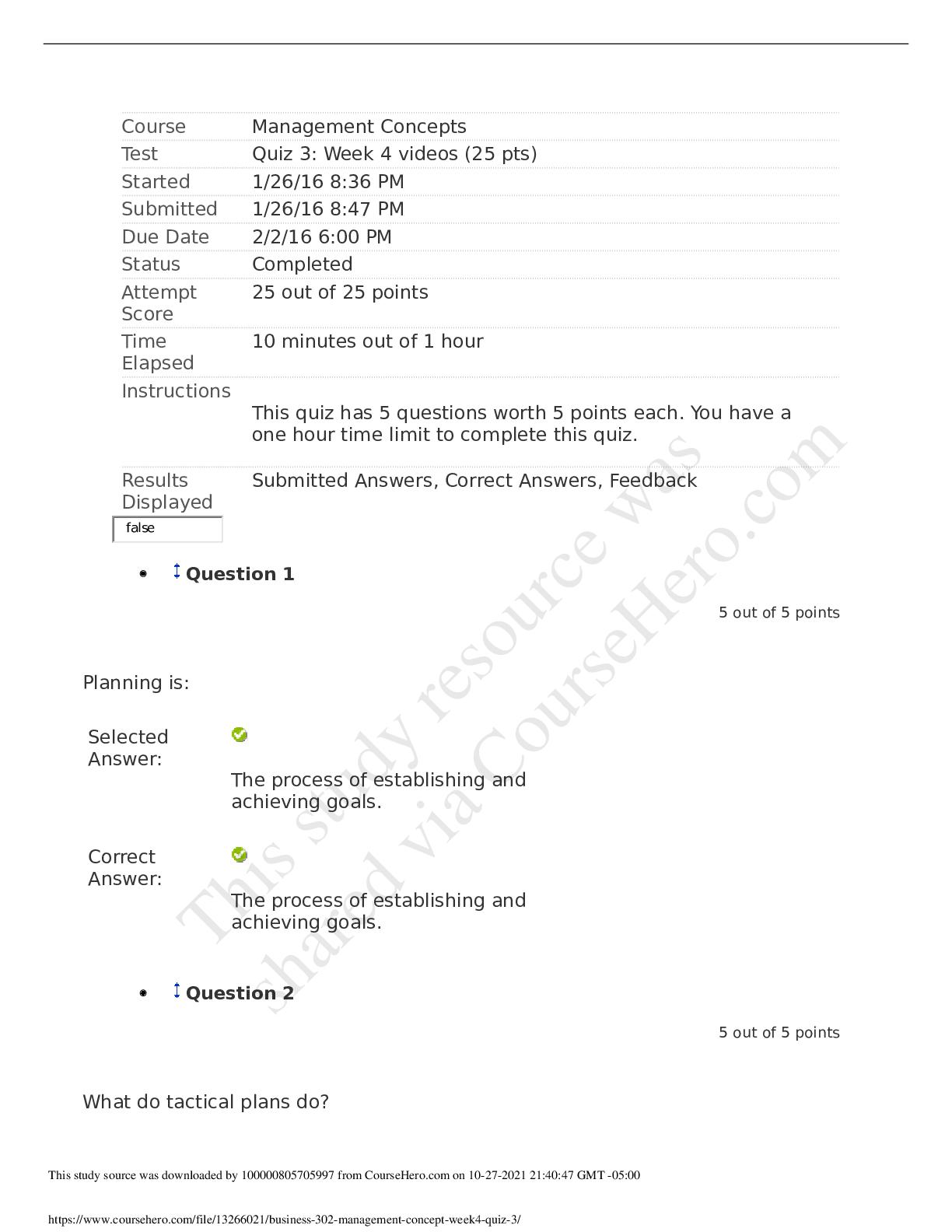

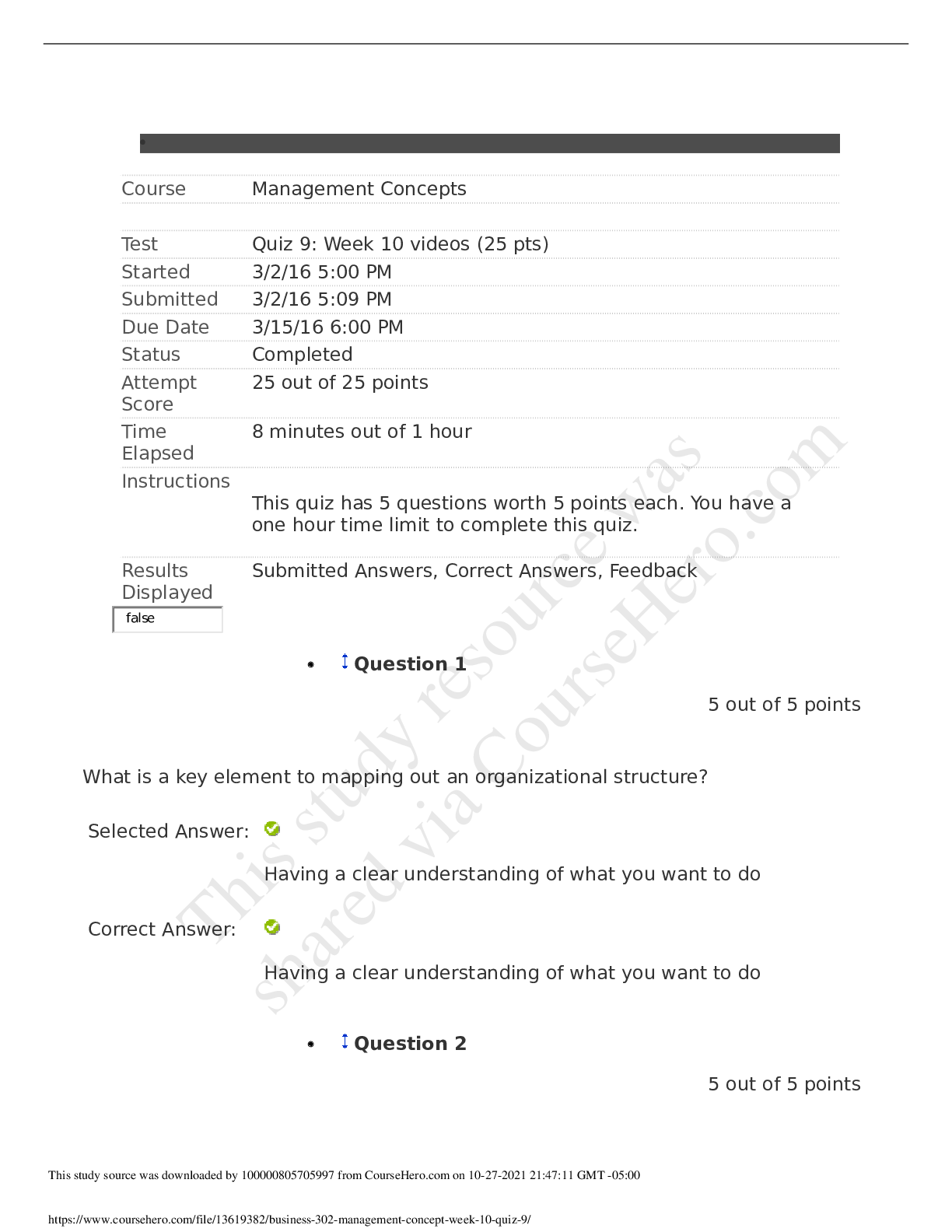

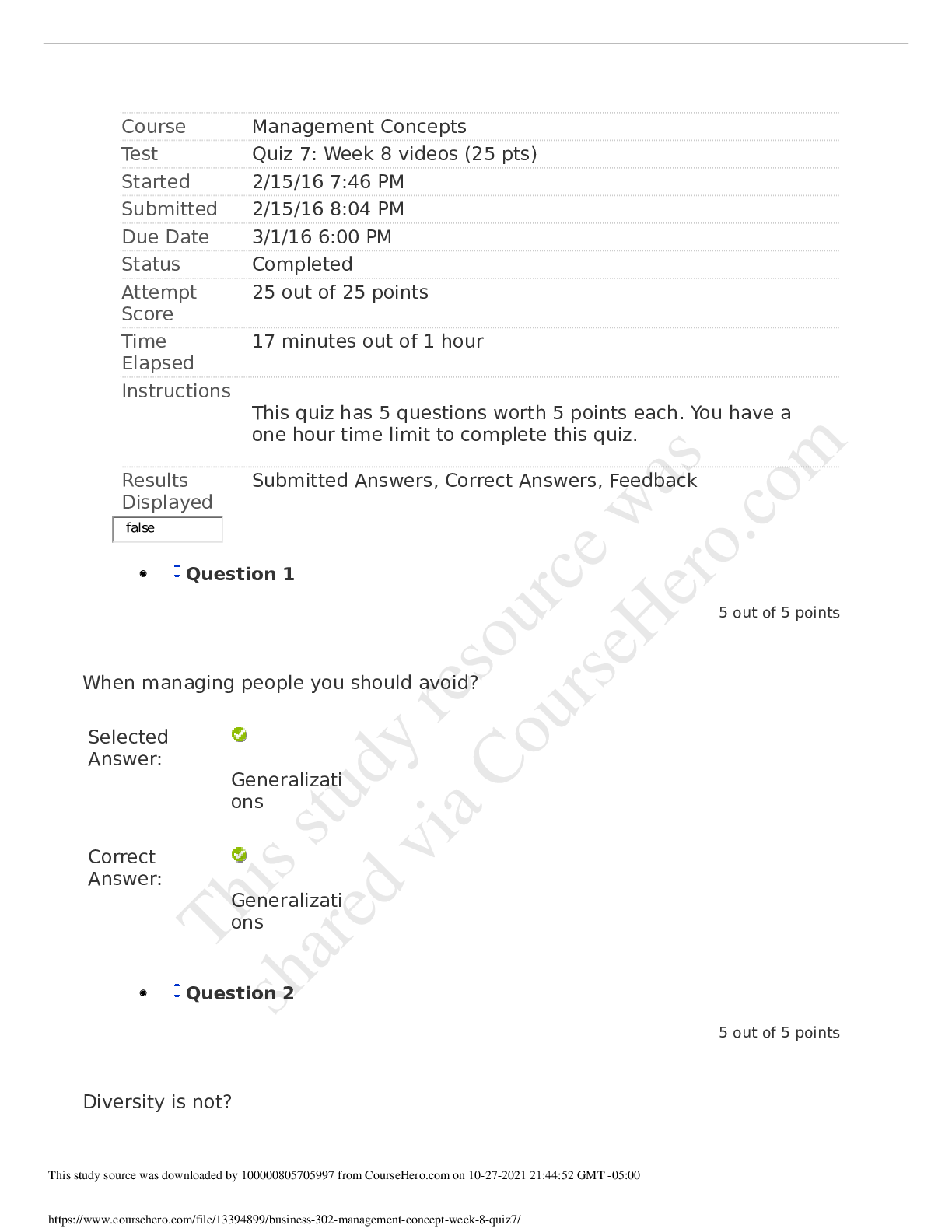

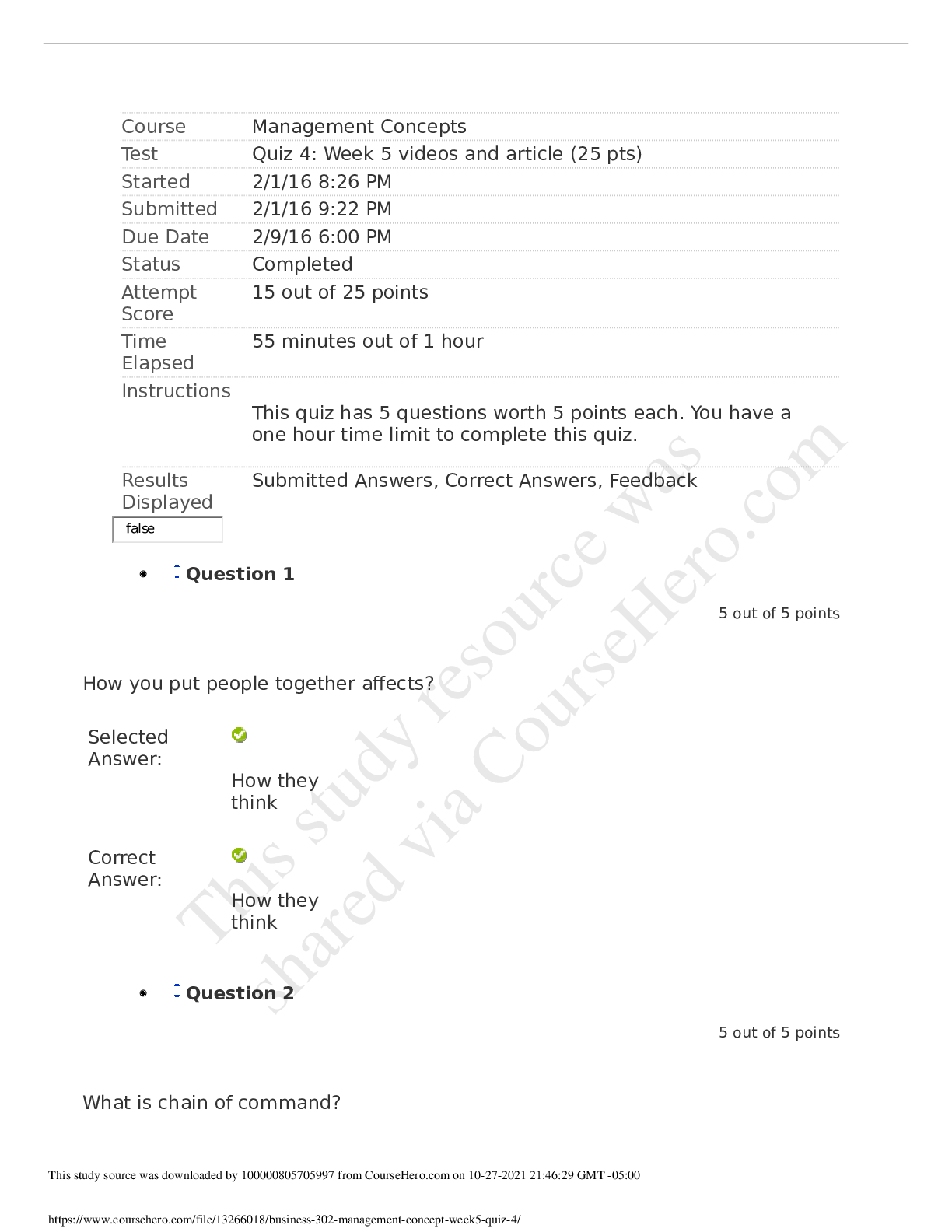


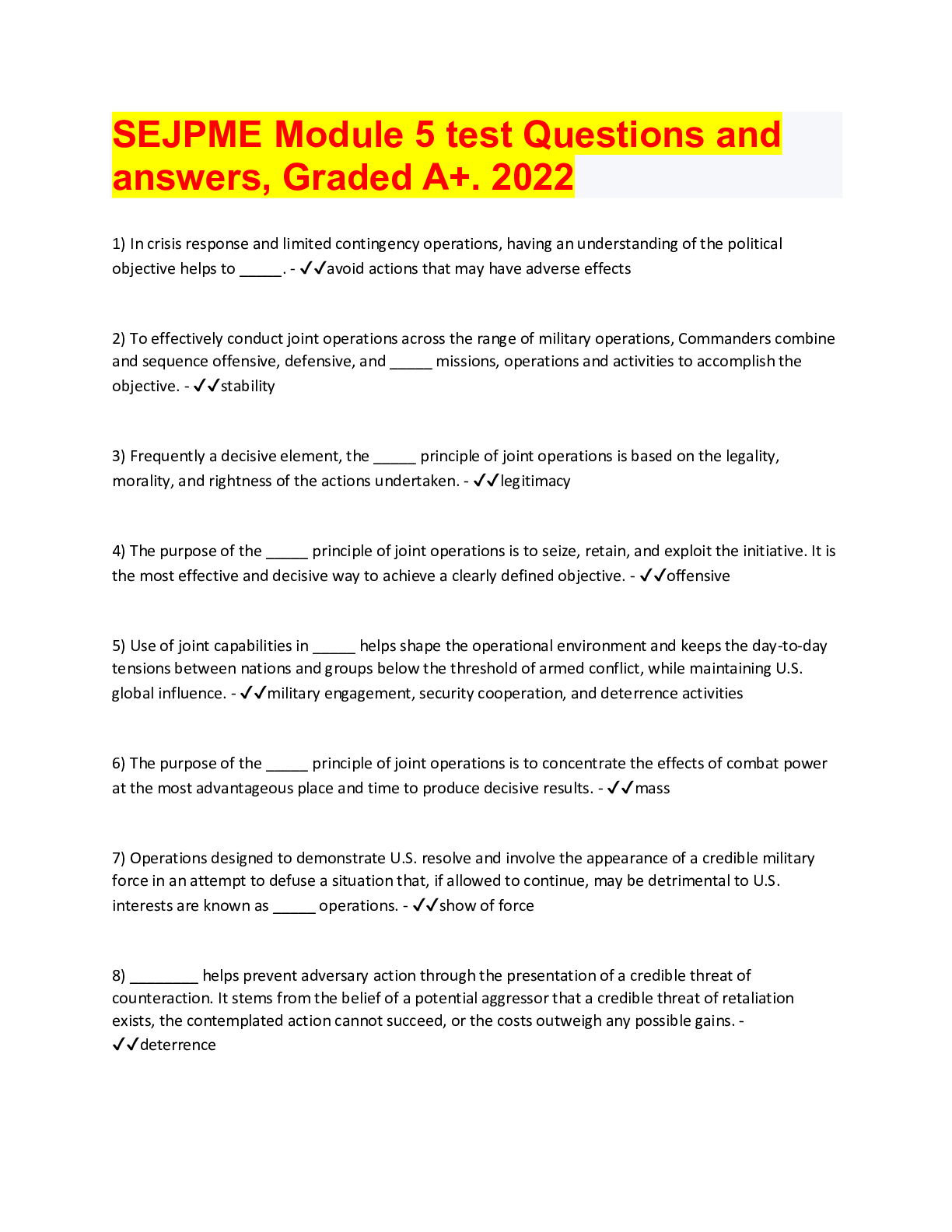

.png)
.png)


